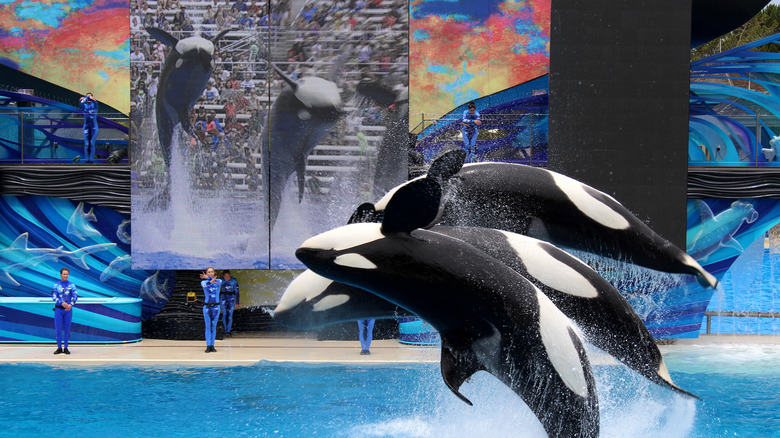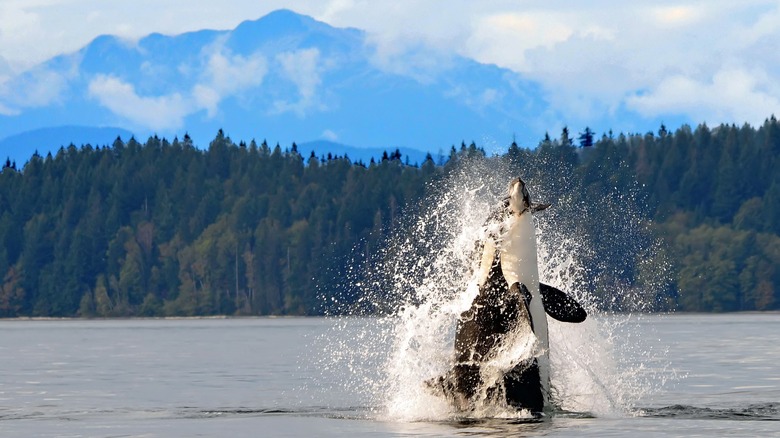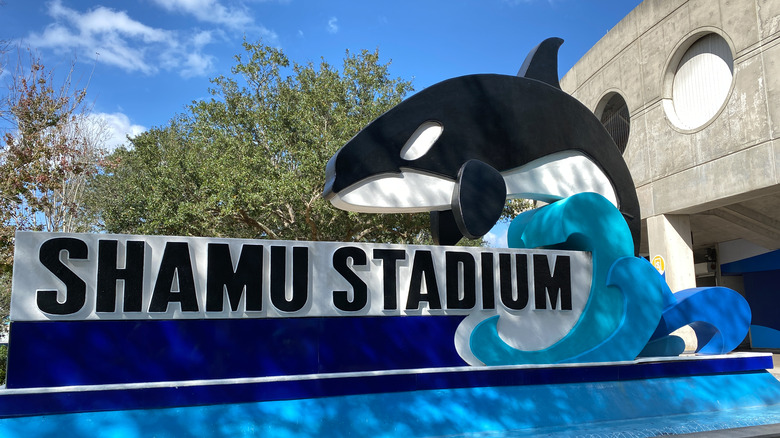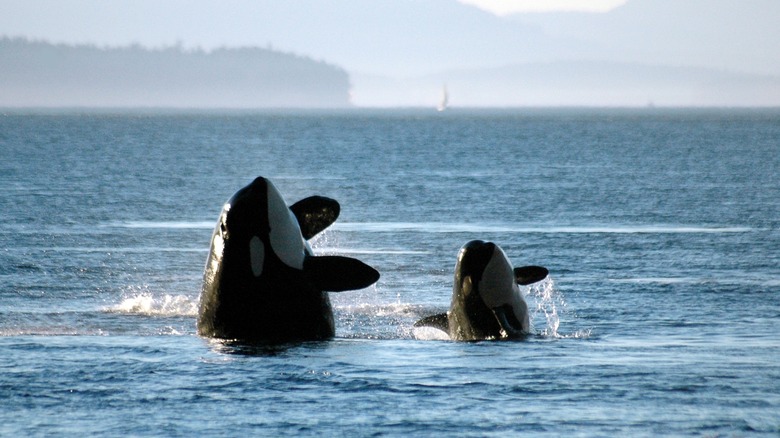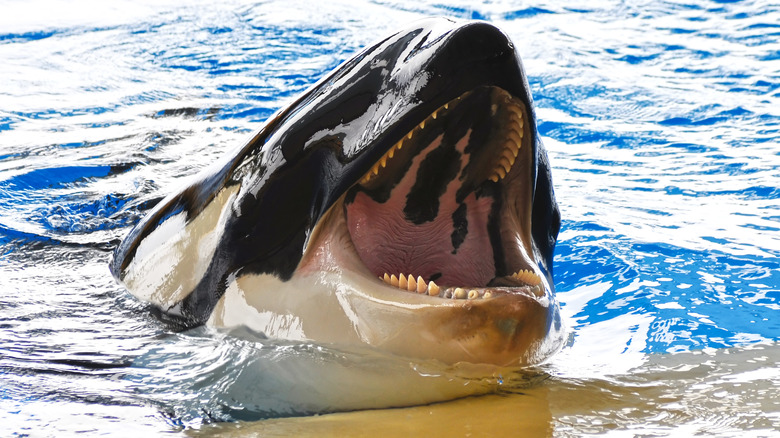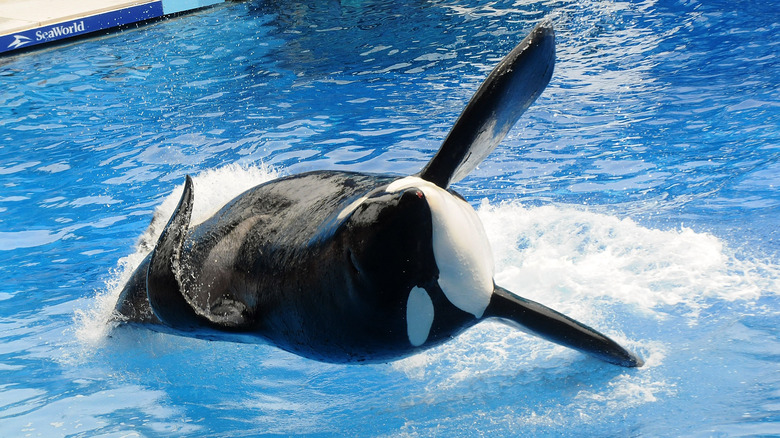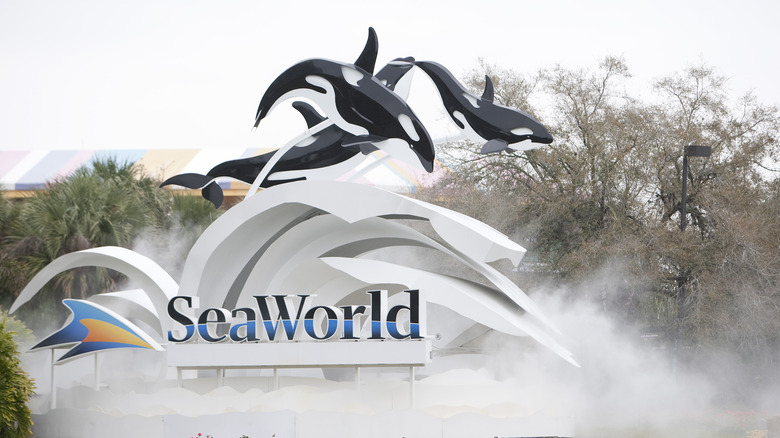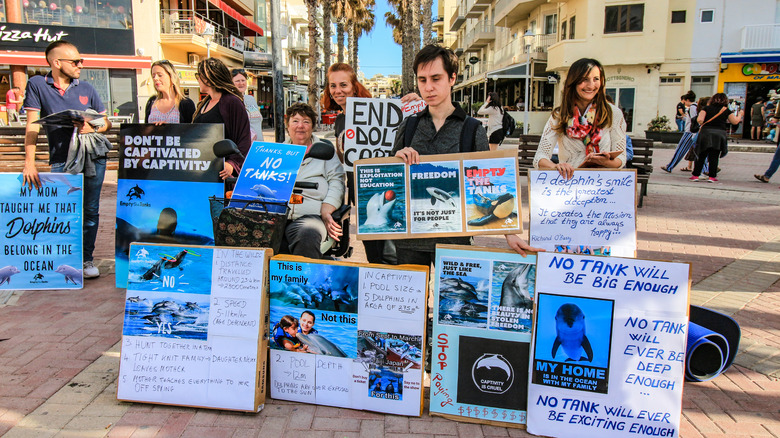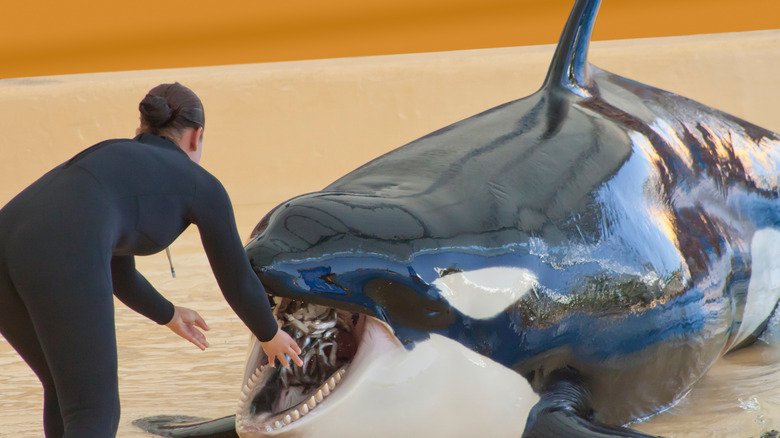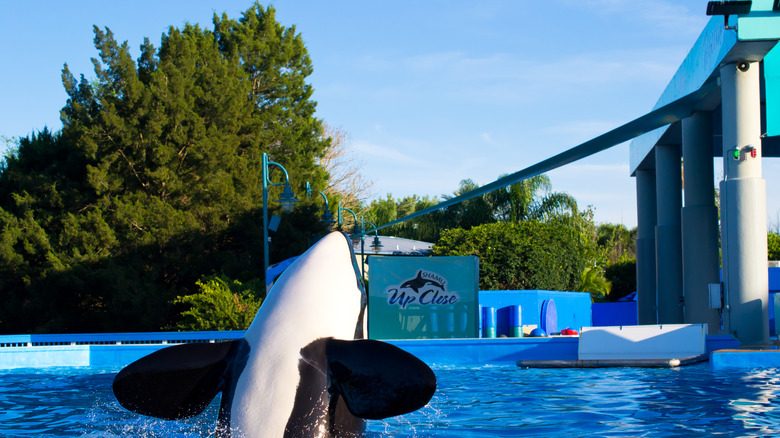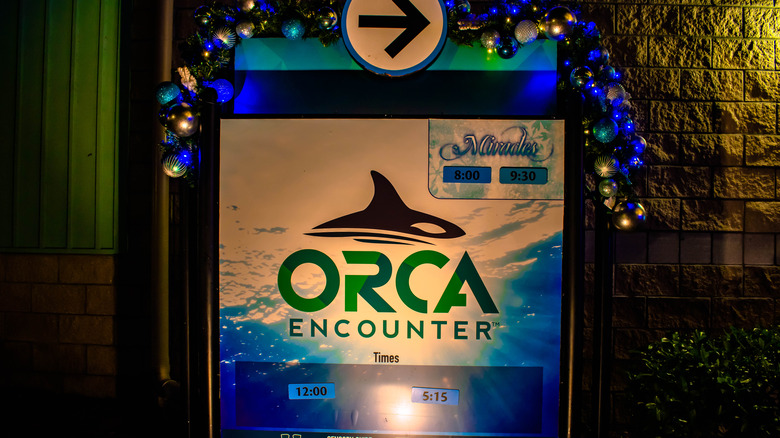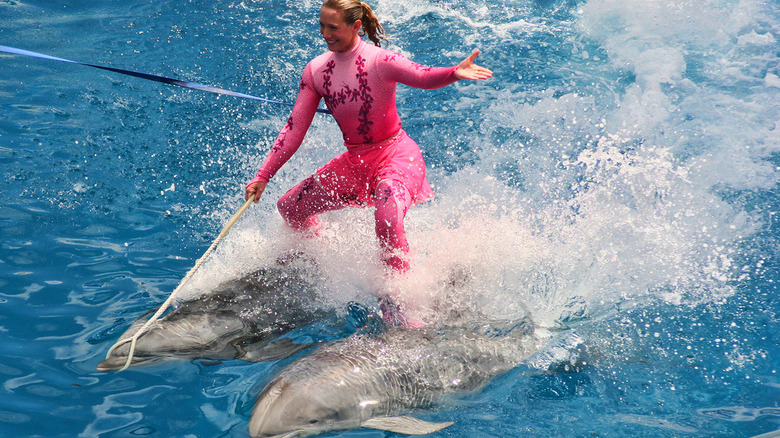The Dark Truth Behind Killer Whale Shows
For over half a century, SeaWorld and similar aquatic theme parks have been marketed as "adventure parks" and destinations for family fun. Visitors watch as marine mammals such as bottlenose dolphins and killer whales spring out of turquoise pools, twirling and splashing in trained synchronicity. Kids dream about what it would be like to be a trainer, dancing with the mammals and rewarding them with fish. Some of these kids grow up to fulfill this dream, only to discover that it is not what it appeared to their younger, starry-eyed selves.
Beneath the surface, killer whale shows have a long history of troubling practices, starting with the process of capturing the earliest generations of captive whales. The conditions of captivity for killer whales, also known as orcas, have proven unsuitable for the several-ton, 20-foot-long, wild animals with highly developed brains. Whale captivity has led to health issues for whales, injuries and even deaths for humans, and several legal and economic consequences for the theme parks that promote and perpetuate it. Here's a deep dive into the dark truth behind killer whale shows.
SeaWorld's early generations of orcas were captured through explosive methods
Following the founding of SeaWorld in 1959, there was a series of "unsuccessful" orca-capturing expeditions that either yielded no captive whales, or yielded whales that died shortly after being captured, per PBS. Prominent early orca-capturing methods included ambushing killer whales as they swam into narrow inlets and capturing the entire pod with a net. When orcas did not swim into areas convenient for capture, some captors would drop "seal bomb" explosives into the water to separate pods and corral whales. These practices led to a significant decrease in the orca population near the coasts of Washington and British Columbia.
Ralph Munro, then a staff aide to former Washington governor Dan Evans, witnessed the orca-capturing process during a weekend sailing expedition. "It was gruesome," he later told the Seattle Times. "There was a guy on the back of the boat with a torch, and he was lighting and dropping these explosives as fast as he could light them, boom, boom, boom, the orcas were screaming ... I can still hear them, screaming back and forth ... They had parts of the pod inside the net, and parts of the pod outside the net. It was just panic, totally disgusting. Sickening."
Munro reached out to the press, which began an investigation into orca-capturing practices that led to a lawsuit from the state of Washington and ended in a ban of SeaWorld's orca-capturing operations in the area.
The captivity of SeaWorld's first Shamu began and ended in tragedy
For decades, Shamu was the face and star of the SeaWorld orca shows, featuring heavily in the company's branding. According to LiveKindly, the original Shamu was the fourth orca captured by SeaWorld. In 1965, the 3-year-old orca was captured after whales harpooned and killed her mother, per Britannica. According to the same source, she "was deprived of food in order to make her learn tricks and was trained to become the park's first performing orca."
In 1971, a woman named Annette Eckis was trying to ride Shamu while preparing for a television appearance. Eckis was wearing a bikini at the time, rather than the full-body wetsuits that trainers typically wore, per the Toledo Blade. Shamu, who may have been attracted by Eckis' unusual attire, held Eckis' leg in her mouth and did not let go until two SeaWorld trainers pried her jaws open with a pole. Eckis had to get more than 100 stitches in her leg, and she sued SeaWorld, which led to Shamu being retired from orca shows.
Four months after the incident, Shamu died of a uterine infection and blood poisoning at SeaWorld. She was just 9 years old at the time. In the wild, the average life expectancy for a female orca is 50 years old, per National Geographic, and some wild orcas live to be 90 years old. Following Shamu's death, SeaWorld trademarked the name Shamu, and proceeded to use it as a stage name for various captive orcas used in shows for the next several decades, according to Britannica.
SeaWorld has routinely separated orca families
The "founding fathers and mothers" of the SeaWorld orca "families" were taken from their pods as calves, and some of their real family members were killed in the capturing process, per National Geographic. As explained in the 2013 documentary "Blackfish," SeaWorld targeted young orcas for capture because the smaller animals would be cheaper to transport from their habitat and between theme parks.
After Washington banned SeaWorld from capturing orcas in state waters, the company moved its orca-capturing operations to Iceland in the late 1970s. The orcas captured in Iceland were sent to mingle in SeaWorld tanks with those captured in the Pacific Northwest. The Pacific and North Atlantic orcas have significantly different vocalization patterns, so the SeaWorld "families" were made up of orphans from different families, regions and, essentially, cultures of orcas. According to National Geographic, wild orcas live in tight-knit family groups with complex cultures. Their brains — the second-largest of any animal on Earth — are highly developed in areas including language and social intelligence.
Mother-calf separation continued beyond initial capture; it frequently took place within the theme parks, too. "I can tell you — my own personal knowledge, [so] this is a conservative number — I know of 19 calves we have taken from their mothers," John Hargrove, former SeaWorld trainer and author of the 2016 book "Beneath the Surface," told NPR. "For example, Kasatka and Takara ... were separated when Takara was 12 [but] they would remain together for life in the wild. ... SeaWorld has separated mothers from their calves before they had stopped nursing."
Captive orcas are kept in cramped tanks associated with poor health and premature death
Since 1977, 70 orcas have been born in captivity, and another 30 died in utero or were stillborn, as noted by National Geographic in 2019. At the time of writing, 37 of the 70 orcas born in captivity had died, and none had lived past the age of 30. Some captive whales, such as Tilikum at SeaWorld and Lolita at Miami Seaquarium, have been forced to live in isolation in small tanks — Lolita lives alone in a pool that is less than twice the length of her body — while others are grouped together in tanks with little space for movement. Captive orcas' poor health and short lifespan is often attributed to their cramped quarters.
"It's basic biology," Naomi Rose, a marine mammal scientist at the Animal Welfare Institute, told National Geographic. "If you have evolved to move great distances to look for food and mates then you are adapted to that type of movement, whether you're a polar bear or an elephant or an orca. You put [orcas] in a box that is 150 feet long by 90 feet wide by 30 feet deep and you're basically turning them into a couch potato."
According to a 2017 study published in Archives of Oral Biology, a quarter of captive orcas have severe tooth damage, while 70% have mild or moderate tooth damage. This damage is primarily caused by whales grinding their teeth against the sides of their tanks, which leads to exposed nerves and open cavities that are susceptible to infection.
Captive breeding whale Tilikum killed three people
Between 1988 and 2009, SeaWorld documented over 100 instances of captive orcas acting aggressively toward trainers, as noted by National Geographic. In 1991, at the now-defunct park Sealand of the Pacific, a trainer named Keltie Byrne drowned as a result of being held underwater by a whale named Tilikum, as reported by CNN. SeaWorld bought Tilikum shortly thereafter and went on to use him as the primary male for orca breeding. He is believed to have sired 21 calves, per National Geographic.
In 1999, the body of a naked man who had allegedly hid in SeaWorld after hours was found in Tilikum's tank. "He may have been a victim of what a whale would call horseplay, just playing around," Orange County Sheriff's Office spokesman Jim Solomons said at the time (via CNN).
Then, following an orca show on February 24, 2010, Tilikum grabbed senior trainer Dawn Brancheau, pulled her into the orca tank, and began swinging her around, as reported by CNN. By the time Brancheau's body was retrieved, she had died of blunt force trauma to the head, neck, and torso, per ABC News. According to Brancheau's autopsy, part of her scalp was "forcibly torn from her head," her jaw was broken, her vertebra was fractured, and an elbow and a knee were dislocated. Orca experts attributed the aggression to the fact that Tilikum was often isolated in small tanks and used excessively for breeding, per NBC News.
SeaWorld took a financial nosedive due to the Blackfish effect
Following the release of the 2013 documentary "Blackfish," which examined the mistreatment of orcas and endangerment of trainers at theme parks, SeaWorld saw a significant commercial decline. According to CBS News, multiple entertainers cancelled planned performances at the park. Mattel discontinued its SeaWorld Trainer Barbie shortly after the documentary's release, per NBC News, and, as reported by the San Diego Union Tribune, travel companies including British Airways, United Airlines, and Virgin Holidays announced that they would no longer promote theme parks that held captive whales and dolphins.
According to a 2018 report in the New York Times, SeaWorld attendance dropped 13% in the months following the release of the documentary. Later in 2014, SeaWorld acknowledged the "Blackfish effect" — the impact of the documentary on the company's reputation and finances — and its stock prices dropped 33%. In 2018, the U.S. Securities and Exchange Commission announced that SeaWorld had agreed to pay $5 million in fines "to settle fraud charges for misleading investors about the impact the documentary film Blackfish had on the company's reputation and business."
In 2020, CBS News reported that SeaWorld had agreed to pay $65 million to settle a lawsuit after the company was accused of misleading investors about the "Blackfish effect."
Blackfish brought momentum to the animal rights movement
Although "Blackfish" was no box-office sensation — it made just $2 million during its theatrical release, per Mic — it has been viewed by millions of people through broadcasts on CNN and streaming services. The kinds of conversations that the documentary generated on social media and among friends also took place among advocacy groups, in business meetings, and within the federal government.
According to National Geographic, hundreds of thousands of viewers signed petitions for SeaWorld to stop exploiting orcas or to shut down completely. U.S. Congressman Adam Schiff pushed a bill to phase out captive orca shows. Animal advocacy groups had already been trying for years, with little success, to take legal action against the U.S. Department of Agriculture for failing to uphold the Animal Welfare Act by failing to oversee the wellbeing of animals kept captive for entertainment purposes. "We were a fringe campaign," Naomi Rose, marine mammal scientist at the Animal Welfare Institute, told National Geographic. "Now we're mainstream. That happened overnight."
In 2014, 38 members of Congress signed a letter and sent it to Agriculture Secretary Tom Vilsack, calling for updated regulations on marine mammal captivity, as reported by CNN. "This situation has garnered great attention by the general public," the letter read, "especially with the release of the documentary film 'Blackfish' that calls into question the feasibility of keeping orcas humanely in captivity due to the enormous physical and psychological impact on orcas kept in confinement and regularly required to perform for the public."
SeaWorld was cited for safety violations five years after Dawn Brancheau's death
Several of the incidents and even deaths that occurred at SeaWorld were positioned in the media as anomalies due to "trainer errors" rather than the result of extremely weighty, naturally wild mammals being unfit for captivity. Stephen Schwarzman — the CEO of SeaWorld's biggest shareholder, Blackstone Group — suggested that the deceased senior trainer Dawn Brancheau "violated all the safety rules we had," as reported by the Orlando Sentinel. Blackstone later apologized and stated that Schwarzman "misspoke."
In 2015, five years after Brancheau's death, the California Division of Occupational Safety and Health at the Department of Industrial Relations issued four citations to SeaWorld San Diego, as reported by the Los Angeles Times. Following a complaint, safety inspectors stated that the theme park failed to train its employees in how to "safely interact with killer whales." The park was fined a total of $25,770. Spokespeople for SeaWorld stated at the time that the park had already made "significant safety enhancements" to the killer whale program. The company appealed the citations, but lost (via Industrial Safety & Hygiene News).
SeaWorld scrapped its habitat expansion project following calls to stop breeding orcas
In 2015, SeaWorld announced its proposed Blue World project, a $100 million plan to double the size of the killer whale tanks at its San Diego park. According to CNN, the California Coastal Commission unanimously approved the proposal, with one condition: SeaWorld could not breed any more captive whales in the state. The theme park company issued a statement saying it was "disappointed" with the condition and said that it would "carefully review and consider" its options (via CNN). According to the San Diego Union Tribune, SeaWorld then sued the California Coastal Commission and argued that the state agency had no legal right to issue the condition on breeding.
But then, in 2016, SeaWorld announced it would stop breeding orcas. "Why the big news? SeaWorld has been listening and we're changing," the company wrote in its official statement announcing the change (via CNN). "Society is changing and we're changing with it."
According to the San Diego Union Tribune, SeaWorld president and CEO Joel Manby said he "agonized" over the decision before ultimately acknowledging that concerns about animal welfare were keeping people from visiting the parks. In a letter to the Los Angeles Times, Manby called the situation a "paradox," adding, "Customers visit our marine parks, in part, to watch orcas. But a growing number of people don't think orcas belong in human care." The company subsequently retracted its lawsuit against the California Coastal Commission and abandoned the Blue World project plans.
SeaWorld added an 'educational' spin to its orca shows
In December 2019, SeaWorld announced it would be retiring its One Ocean orca shows from its Orlando and San Antonio parks at the end of the year, as reported by Orlando Weekly. This news came two and a half years after the debut of a new show called Orca Encounter in the San Diego park. "Guests will learn about killer whales' role in the ocean ecosystem, behaviors the animals exhibit in the wild, the importance of conservation to their habitat, and animal welfare practices at SeaWorld," Dr. Chris Dold, Chief Zoological Officer at SeaWorld Parks, said of the Orca Encounter show (via Orlando Weekly).
The original One Ocean shows had a focus on the theatrical, with dramatic musical numbers and emotional storylines, while the updated Orca Encounter show was marketed as having an educational spin, featuring videos on orca biology. As the captive whales performed tricks in between videos, the trainers talked about why the tricks were "necessary to ensure the continued health of the animals." Still, public concerns regarding the size of the orca tanks remained after plans to expand them were scrapped, while animal advocacy groups continued to advocate against whale captivity as a whole.
PETA launched a successful campaign to end dolphin riding at SeaWorld
Calls for SeaWorld to change its practices have extended beyond captive orcas. In 2020, SeaWorld agreed to stop the practice of performers riding and "surfing" on bottlenose dolphins and standing on their noses, or rostrums, during performances, as reported by CNN and other outlets. People for the Ethical Treatment of Animals, known as PETA, was one of the leading forces behind the change with a campaign that followed a veterinary report that found "open wounds and extensive scarring" on SeaWorld dolphins, which the theme park company subsequently denied.
"It's unacceptable for smart, sensitive dolphins to be used as surfboards and launch pads in these cruel and demeaning stunts," PETA Executive Vice President Tracy Reiman said (via PETA). "The very least that SeaWorld trainers can do for the miserable animals in their custody is not stand or ride on them, and PETA is taking action to end this practice immediately."
PETA obtained 163 shares of SeaWorld in order to be heard at a shareholder meeting. "In order to address the most pressing issue that SeaWorld faces today — the public's continued opposition to captive-animal displays — the shareholders urge the board to stop allowing trainers to stand on dolphins' faces and ride on their backs in exploitative and potentially harmful circus-style shows," the group's proposal stated. A lengthy letter from a SeaWorld Entertainment lawyer to the Securities and Exchange Commission contested PETA's claims as "unclear and misleading" and claimed the dolphin shows were harmless, but ultimately agreed to end the practices.
